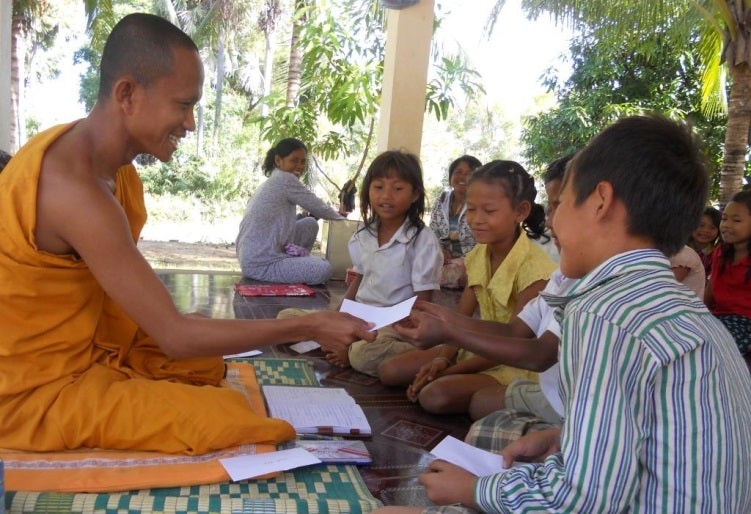by Chivith Rottanak
“…children talked about the reasons that they do not tell others, especially adults, about incidents of violence…”

March 23, 2015. The 2006 United Nations Secretary General’s (UNSG) 2006 recommended that countries develop and implement “systematic national data collection and research” on violence against children. In 2013, the Government of Cambodia responded to the UNSG’s call to action by becoming the first country in the East Asia and Pacific Region to implement a cross-sectional household survey on violence against children that measures the prevalence of physical, emotional and sexual violence against both girls and boys, in addition to identifying risk and protective factors, as well as health consequences of violence. The results, released in October 2014, were sobering: over three-quarters of children surveyed reported more than one incident of physical violence, emotional violence, or sexual abuse prior to age 18.
Highlights of key findings
- More than half of all Cambodian children are physically abused. Children recalled being punched, kicked, whipped or beaten with an object.
- One quarter of Cambodian children are emotionally abused by a parent, caregiver or other adult relative.
- Approximately 5 percent of males and females (aged 18–24) reported at least one experience of sexual abuse prior to age 18, and 6.4 percent of girls and 5.2 percent of boys (aged 13–17) reported at least one incident of sexual abuse.
Physical violence
Children personally experienced and witnessed violence in schools, homes and communities. Boys reported direct experiences of violence in the home more than girls, but nearly all children recalled incidents of violence in their communities. In school, violence was reported as occurring between children of the same age, usually in the form of bullying and fighting. Children also reported being beaten by older children. Children described a wide range of ways physical discipline was meted out by teachers as punishment for unapproved behaviors.
Emotional violence
Both girls and boys described being “blamed” and “cursed at” by parents, which made them feel “sad,” “depressed” and “demotivated to study.” Children reported not understanding why they were being admonished. They found being berated confusing and indicated a build-up of resentment towards their parents or caregivers.
Sexual abuse
Both boys and girls reported being sexually abused. Most girls revealed being personally violated sexually, including being raped and being touched inappropriately. Boys discussed rumors of rape or cited specific instances of rape in their communities. Both boys and girls linked sexual violence to trafficking. They discussed the sexual assault of girls, mainly by male adults, as well as violence against women perpetrated by husbands.
Service-seeking behavior
In the qualitative research, children talked about the reasons that they do not tell others, especially adults, about incidents of violence either committed against them or witnessed by them. A major reason among girls and young women for not disclosing their violation or seeking help was that they feared being admonished for telling tales. In Cambodian culture, there is a strong taboo against children speaking negatively about adults. Girls reported that it was particularly difficult to talk about sexual violence because adults might find it unacceptable for girls to speak words of a sexual nature, regardless of the context.
Boys said that they did not tell anyone about specific incidents because they were too shy, because they felt no one could help, and because, like the girls, they feared being accused of speaking against adults. Older males complained that inconsistent police and judicial actions discouraged them from reporting violence and seeking help. Boys were more likely than girls to explicitly state that they did not or would not tell someone about an incident of violence.
Discussion
The data from this study offer rich opportunities to identify risk and protective factors critical for the development of effective prevention programs and policies. The findings will also allow a deeper analysis of the intersecting contexts in which violence occurs. This will help to better clarify the factors behind multiple forms of violence. In addition, a better understanding of the co-occurrence of sexual, physical and emotional violence can prime service providers to better deliver comprehensive care for children affected by violence and more quickly identify both risk factors and protective measures.
Related Resources
Findings from Cambodia’s Violence Against Children Survey 2013
Findings from Cambodia’s Violence Against Children Survey: Qualitative Research
 Chivith Rottanak is a UNICEF child protection officer based in Cambodia and a Spring 2015 G. Barrie Landry fellow at the FXB Center for Health & Human Rights.
Chivith Rottanak is a UNICEF child protection officer based in Cambodia and a Spring 2015 G. Barrie Landry fellow at the FXB Center for Health & Human Rights.

